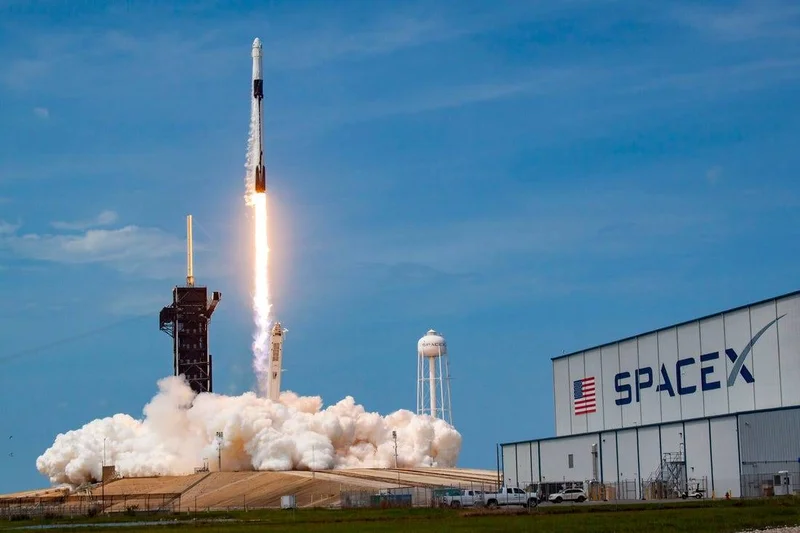Florida's Sky-High Record: Not Just a Number, But a Launchpad to Tomorrow
When the news broke late Monday night that Florida had shattered its annual launch record, hitting 94 orbital-class missions, I honestly just sat back in my chair, speechless. Ninety-four launches! Think about that for a second. It’s not just a statistic for the history books; it’s a seismic shift, a clear signal that humanity isn't just dabbling in space anymore. We're building expressways to the stars, and the Space Coast is rapidly becoming the busiest on-ramp on Earth.
For years, we’ve talked about the promise of space, the potential for a future beyond our pale blue dot. But seeing that number, 94, it’s like watching a blueprint suddenly transform into a bustling metropolis. The Starlink 6-87 mission, a late-night Falcon 9 flight adding another 29 broadband satellites to the ever-growing constellation, was the one that pushed us over the edge. It lifted off from Cape Canaveral Space Force Station's Pad 40 at 10:21 p.m. EST, a testament to the relentless pace. This wasn't just a SpaceX show, either; United Launch Alliance’s Atlas 5 and Vulcan rockets, and even Blue Origin’s New Glenn, all contributed to this incredible tally. But let’s be real, SpaceX, with its Falcon 9s, is largely the engine driving this revolution, accounting for around 95% of Florida’s launches. Their cadence, their almost unbelievably rapid reusability – it’s fundamentally reshaping what we even consider possible.
The New Normal: Space as an Industrial Frontier
This isn't your grandad's space race anymore. This is something entirely different. We’re witnessing the industrialization of space access, a transformation so profound it’s like comparing the early days of flight to today’s global air travel network. Remember when a single launch was a monumental event, meticulously planned for months, if not years? Now, we’re talking about launches happening with airport-like frequency, and the infrastructure on the ground is scrambling to keep up.
Take the Monday night record-breaker, for instance. It was originally slated for earlier in the day, but got pushed back because the Federal Aviation Administration, grappling with air traffic controller shortages during a government shutdown, had to limit commercial launches to a specific nighttime window. Think about that: a government shutdown and air traffic controller availability are now direct constraints on our ability to launch rockets into orbit! It’s a fascinating, almost absurd, snapshot of how integrated and normal spaceflight is becoming. The weather, too, was a factor, with meteorologists citing concerns from strong liftoff winds and upper-level wind shear. Yet, they launched. They always do. Because the imperative to build, to connect, to explore, is simply too strong.

And it’s not just about getting rockets up. It's about bringing them back. The booster for this record-setting mission, B1096, a newer Falcon 9, completed its third flight, landing autonomously on the drone ship ‘Just Read the Instructions’ just eight minutes after liftoff. That’s the 532nd booster landing to date! When I first saw the demo of a Falcon 9 landing, I honestly just sat back in my chair, speechless. We're literally catching rockets mid-air, or rather, guiding them back to Earth with pinpoint precision. This isn't just cool tech; it's the economic backbone of this new era, enabling the kind of reusability that makes these frequent launches financially viable. What happens when this kind of rapid iteration and cost reduction is applied to everything we send into space? We're talking about a paradigm shift in how we conceive of space infrastructure, from global internet constellations like Starlink and Amazon's Kuiper to future lunar bases and beyond.
Beyond the Numbers: What This Cadence Unleashes
The impact of this unprecedented launch cadence echoes far beyond the launch pads themselves. Just look at Port Canaveral. Captain John Murray's report noted 90 boosters and 194 payload fairings brought into port for Fiscal Year 2025. These aren't just numbers; they're physical components of an expanding space economy, a tangible manifestation of our growing footprint in the cosmos. You see it in the comments sections of tech blogs, on forums like Reddit, where people are asking, "What’s next? When do we start seeing true space tourism become routine?" or "How soon until the internet from space truly covers every corner of the globe?"
This isn’t just about putting satellites into orbit; it’s about what those satellites do. Starlink, for example, is building a global nervous system, connecting the unconnected, bridging digital divides that seemed insurmountable just a few years ago. Imagine a world where reliable, high-speed internet is a universal right, delivered from space. What kind of innovation, what kind of education, what kind of human connection does that unlock? It’s a profound question, one that forces us to confront not just the technological marvels but also the ethical responsibilities that come with such power. We have to ensure this incredible access is used for good, for global betterment, and that the space environment itself is protected for generations to come.
This relentless drive to launch, to iterate, to expand, it's like a grand symphony where every launch is a note, building to a crescendo of human ambition. Back in 2022, U.S. Space Force 2nd Lt. Christian Jackson talked about training for an "airport-like flight environment," predicting we’d hit 100 launches a year. We're almost there, and we're seeing double-launch days become common. This means the gap between today and tomorrow is closing faster than we can even comprehend, pushing us into a future where space isn't just a destination, but an extension of our daily lives, a crucial part of our global infrastructure. It's a truly exhilarating time to be alive, isn't it?
